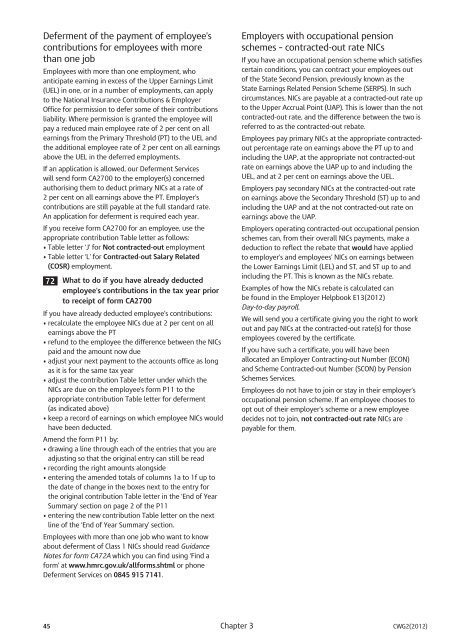Employer Further Guide to PAYE and NICs - HM Revenue & Customs
Employer Further Guide to PAYE and NICs - HM Revenue & Customs
Employer Further Guide to PAYE and NICs - HM Revenue & Customs
You also want an ePaper? Increase the reach of your titles
YUMPU automatically turns print PDFs into web optimized ePapers that Google loves.
Deferment of the payment of employee’s<br />
contributions for employees with more<br />
than one job<br />
Employees with more than one employment, who<br />
anticipate earning in excess of the Upper Earnings Limit<br />
(UEL) in one, or in a number of employments, can apply<br />
<strong>to</strong> the National Insurance Contributions & <strong>Employer</strong><br />
Office for permission <strong>to</strong> defer some of their contributions<br />
liability. Where permission is granted the employee will<br />
pay a reduced main employee rate of 2 per cent on all<br />
earnings from the Primary Threshold (PT) <strong>to</strong> the UEL <strong>and</strong><br />
the additional employee rate of 2 per cent on all earnings<br />
above the UEL in the deferred employments.<br />
If an application is allowed, our Deferment Services<br />
will send form CA2700 <strong>to</strong> the employer(s) concerned<br />
authorising them <strong>to</strong> deduct primary <strong>NICs</strong> at a rate of<br />
2 per cent on all earnings above the PT. <strong>Employer</strong>’s<br />
contributions are still payable at the full st<strong>and</strong>ard rate.<br />
An application for deferment is required each year.<br />
If you receive form CA2700 for an employee, use the<br />
appropriate contribution Table letter as follows:<br />
• Table letter ‘J’ for Not contracted-out employment<br />
• Table letter ‘L’ for Contracted-out Salary Related<br />
(COSR) employment.<br />
72 What <strong>to</strong> do if you have already deducted<br />
employee’s contributions in the tax year prior<br />
<strong>to</strong> receipt of form CA2700<br />
If you have already deducted employee’s contributions:<br />
• recalculate the employee <strong>NICs</strong> due at 2 per cent on all<br />
earnings above the PT<br />
• refund <strong>to</strong> the employee the difference between the <strong>NICs</strong><br />
paid <strong>and</strong> the amount now due<br />
• adjust your next payment <strong>to</strong> the accounts office as long<br />
as it is for the same tax year<br />
• adjust the contribution Table letter under which the<br />
<strong>NICs</strong> are due on the employee’s form P11 <strong>to</strong> the<br />
appropriate contribution Table letter for deferment<br />
(as indicated above)<br />
• keep a record of earnings on which employee <strong>NICs</strong> would<br />
have been deducted.<br />
Amend the form P11 by:<br />
• drawing a line through each of the entries that you are<br />
adjusting so that the original entry can still be read<br />
• recording the right amounts alongside<br />
• entering the amended <strong>to</strong>tals of columns 1a <strong>to</strong> 1f up <strong>to</strong><br />
the date of change in the boxes next <strong>to</strong> the entry for<br />
the original contribution Table letter in the ‘End of Year<br />
Summary’ section on page 2 of the P11<br />
• entering the new contribution Table letter on the next<br />
line of the ‘End of Year Summary’ section.<br />
Employees with more than one job who want <strong>to</strong> know<br />
about deferment of Class 1 <strong>NICs</strong> should read Guidance<br />
Notes for form CA72A which you can find using ‘Find a<br />
form’ at www.hmrc.gov.uk/allforms.shtml or phone<br />
Deferment Services on 0845 915 7141.<br />
<strong>Employer</strong>s with occupational pension<br />
schemes – contracted-out rate <strong>NICs</strong><br />
If you have an occupational pension scheme which satisfies<br />
certain conditions, you can contract your employees out<br />
of the State Second Pension, previously known as the<br />
State Earnings Related Pension Scheme (SERPS). In such<br />
circumstances, <strong>NICs</strong> are payable at a contracted-out rate up<br />
<strong>to</strong> the Upper Accrual Point (UAP). This is lower than the not<br />
contracted-out rate, <strong>and</strong> the difference between the two is<br />
referred <strong>to</strong> as the contracted-out rebate.<br />
Employees pay primary <strong>NICs</strong> at the appropriate contractedout<br />
percentage rate on earnings above the PT up <strong>to</strong> <strong>and</strong><br />
including the UAP, at the appropriate not contracted-out<br />
rate on earnings above the UAP up <strong>to</strong> <strong>and</strong> including the<br />
UEL, <strong>and</strong> at 2 per cent on earnings above the UEL.<br />
<strong>Employer</strong>s pay secondary <strong>NICs</strong> at the contracted-out rate<br />
on earnings above the Secondary Threshold (ST) up <strong>to</strong> <strong>and</strong><br />
including the UAP <strong>and</strong> at the not contracted-out rate on<br />
earnings above the UAP.<br />
<strong>Employer</strong>s operating contracted-out occupational pension<br />
schemes can, from their overall <strong>NICs</strong> payments, make a<br />
deduction <strong>to</strong> reflect the rebate that would have applied<br />
<strong>to</strong> employer’s <strong>and</strong> employees’ <strong>NICs</strong> on earnings between<br />
the Lower Earnings Limit (LEL) <strong>and</strong> ST, <strong>and</strong> ST up <strong>to</strong> <strong>and</strong><br />
including the PT. This is known as the <strong>NICs</strong> rebate.<br />
Examples of how the <strong>NICs</strong> rebate is calculated can<br />
be found in the <strong>Employer</strong> Helpbook E13(2012)<br />
Day-<strong>to</strong>-day payroll.<br />
We will send you a certificate giving you the right <strong>to</strong> work<br />
out <strong>and</strong> pay <strong>NICs</strong> at the contracted-out rate(s) for those<br />
employees covered by the certificate.<br />
If you have such a certificate, you will have been<br />
allocated an <strong>Employer</strong> Contracting-out Number (ECON)<br />
<strong>and</strong> Scheme Contracted-out Number (SCON) by Pension<br />
Schemes Services.<br />
Employees do not have <strong>to</strong> join or stay in their employer’s<br />
occupational pension scheme. If an employee chooses <strong>to</strong><br />
opt out of their employer’s scheme or a new employee<br />
decides not <strong>to</strong> join, not contracted-out rate <strong>NICs</strong> are<br />
payable for them.<br />
45 Chapter 3 CWG2(2012)

















